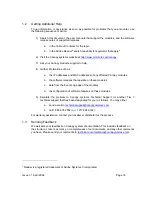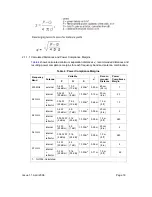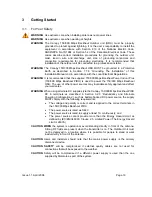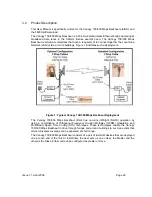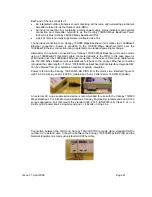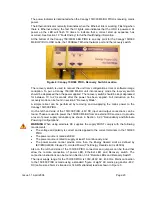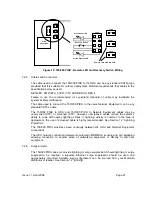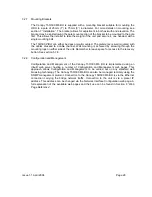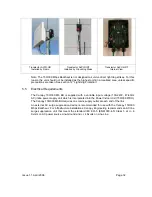
Issue 1.1 April 2006
Page 17
2 AVOIDING
HAZARDS
2.1 Preventing
Overexposure to RF Energy
Caution! To protect from overexposure to RF energy, install Canopy radios so as to provide
and maintain the minimum separation distances from all persons shown in
When the system is operational, avoid standing directly in front of the antenna. Strong RF
fields are present when the transmitter is on. The Outdoor Unit (ODU) must not be deployed
in a location where it is possible for people to stand or walk inadvertently in front of the
antenna.
Table 3: Exposure separation distances
Canopy module
Minimum separation distance from all persons
Antenna of 900-MHz AP or SM
60 cm
24 in
2.4-, 5.2-, 5.4-, or 5.7-GHz radio
with no reflector
20 cm
8 in
2.4-, 5.2-, 5.4-, or 5.7-GHz radio
with a reflector
1.5 m
60 in (5 ft)
At these and greater separation distances, the power density from the RF field is below
generally accepted limits for the general population.
NOTE:
These are conservative distances that include compliance margins. In the case of
the reflector, the distance is even more conservative because the equation used
models the reflector as a point source and ignores its physical dimensions.
2.1.1 Calculations for Separation Distances and Power Compliance Margins
Limits and guidelines for RF exposure come from:
◦
US FCC limits for the general population. See the FCC web site at
, and the policies, guidelines, and requirements in Part 1 of Title 47
of the Code of Federal Regulations, as well as the guidelines and suggestions for
evaluating compliance in FCC OET Bulletin 65.
◦
Health Canada limits for the general population. See the Health Canada web site at
◦
ICNIRP
(International
Commission on Non-Ionizing Radiation Protection) guidelines
for the general public. See the ICNIRP web site at http://www.icnirp.de/ and
Guidelines for Limiting Exposure to Time-Varying Electric, Magnetic, and
Electromagnetic Fields.
The applicable power density exposure limits from the documents referenced above are
◦
6
W/m
2
for RF energy in the 900-MHz frequency band in the US and Canada.
◦
10
W/m
2
for RF energy in the 2.4-, 5.2-, 5.4-, and 5.7-GHz frequency bands.
Peak power density in the far field of a radio frequency point source is calculated as follows:
Содержание Canopy 150 Mbps Backhaul
Страница 1: ...Canopy 150 300 Mbps Backhaul User Guide BH150 300 UG en Issue 1 1 April 2006 ...
Страница 25: ...Issue 1 1 April 2006 Page 24 Figure 5 Canopy 150 300 PIDU Power Input ...
Страница 66: ...Issue 1 1 April 2006 Page 65 Figure 29 Save and Restore Configuration Page Figure 30 Save File Pop up ...
Страница 97: ...Issue 1 1 April 2006 Page 96 Figure 59 Spectrum Management Help Page ...
Страница 162: ...Issue 1 1 April 2006 Page 161 Figure A8 Surge Arrestor ALPU ORT Connection Illustration ...
Страница 167: ...Issue 1 1 April 2006 Page 166 Figure 113 64 QAM 0 92 Dual Payload Figure 114 256 QAM 0 81 Dual Payload ...














